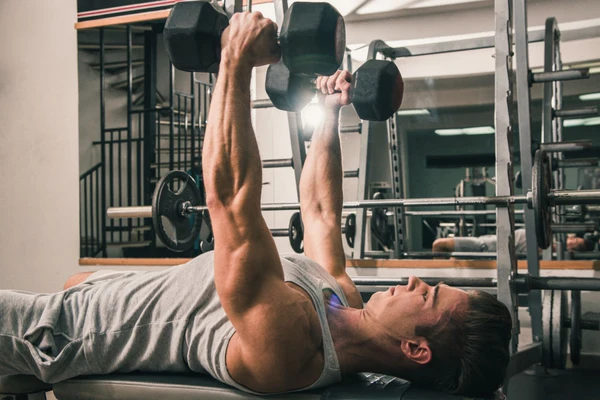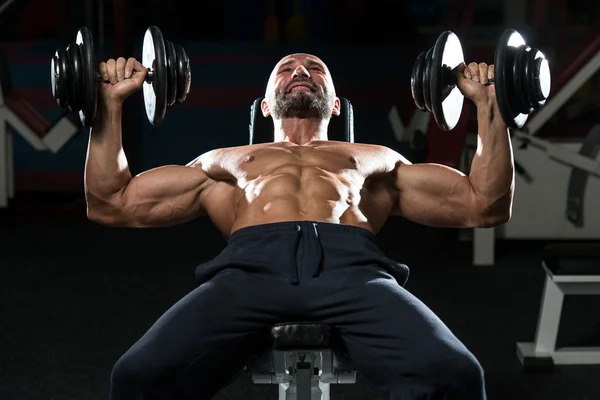Best Guide to Chest Workouts with Dumbbells: Build Mass, Strength, and Definition
If you’re serious about building a bigger, stronger chest, dumbbells might be your most underutilized weapon.
As a bodybuilder who’s spent years refining my chest training with every piece of equipment imaginable, I can confidently say that dumbbells offer a unique blend of freedom, muscle activation, and injury prevention that barbells and machines simply can’t match.
This guide is designed to help you master dumbbell chest workouts—whether you’re training at home or in the gym.
We’ll explore the anatomy of the chest, explain why dumbbells are superior in many cases, outline training strategies for all levels, and give you a detailed dumbbell chest routine with variations and progressions.
Why Dumbbells Deserve a Spot in Your Chest Routine
Let’s get something straight: barbell bench presses are great for building strength and moving serious weight, but they come with limitations.
Dumbbells allow for greater range of motion, activate more stabilizer muscles, and can help correct muscle imbalances between your left and right side.

Key Advantages of Dumbbells:
- Greater Range of Motion: You can lower the dumbbells deeper than a barbell allows, getting a better stretch on the pecs.
- Muscle Symmetry: Dumbbells force each side of your body to work independently, addressing any size or strength imbalances.
- Improved Joint Safety: Dumbbells allow your wrists, shoulders, and elbows to move naturally, reducing strain and injury risk.
- Stability and Control: Because there’s no fixed path like a machine or barbell, your stabilizer muscles work harder—especially your rotator cuffs and core.
Understanding Chest Anatomy: What You’re Really Training
The chest, or pectoralis major, is a fan-shaped muscle with two primary heads:
Clavicular Head (Upper Chest) – This part is activated most during incline movements.
Sternal Head (Middle & Lower Chest) – Best targeted with flat and decline pressing movements.
Supporting muscles like the triceps and anterior deltoids also come into play, especially during compound lifts.
Knowing how to isolate and emphasize different areas of the chest can help you develop a full, balanced look.
Core Principles for Effective Dumbbell Chest Training
Before diving into the exercises, here are foundational principles that apply whether you’re a beginner or an experienced lifter:
Progressive Overload
Muscle growth (hypertrophy) requires gradually increasing the demands you place on the chest. You can do this by:
- Adding weight
- Increasing reps
- Improving time under tension
- Reducing rest intervals
Form Over Ego
You can’t build your chest if your shoulders are doing all the work. Control each rep, keep your scapula retracted, and focus on feeling the muscle stretch and contract.
Volume and Frequency
For hypertrophy, 10–20 sets per week for the chest is ideal, split across 2–3 workouts. Dumbbell workouts can be tailored to fit into full-body, upper/lower, or push-pull-legs routines.
Mind-Muscle Connection
Your ability to consciously contract your pecs is key. Slow down your reps, especially on the eccentric (lowering) phase, and squeeze the top of every rep.
The Dumbbell Chest Arsenal: Top Exercises
Below is a categorized breakdown of the best dumbbell chest exercises, each serving a distinct role in developing your pecs.
-
Dumbbell Bench Press (Flat, Incline, Decline)
How To: Lie on a bench and press the dumbbells from chest level to full extension. Don’t let them touch at the top—keep tension on the chest.
- Flat: Emphasizes the mid-chest.
- Incline: Targets the upper pecs.
- Decline: Hits the lower pecs and can relieve shoulder stress.
Pro Tip: Rotate your palms slightly inward (a semi-pronated grip) to reduce shoulder strain and increase chest engagement.
-
Dumbbell Flyes (Flat, Incline, Decline)
How To: Start with arms extended above chest, palms facing each other. Lower arms out wide in an arc until you feel a deep stretch, then bring them back together.
Variation: Use a slow 3-1-1 tempo (3 seconds lowering, 1 second hold, 1 second up) to maximize tension.
Caution: Don’t go too heavy—this is a stretch-focused, isolation movement.
-
Dumbbell Pullover
How To: Lie on a flat bench, holding one dumbbell with both hands. Extend arms above your chest and lower the weight behind your head in an arc, then return.
Benefits: Stretches the pecs and lats simultaneously. Great for chest expansion and rib cage mobility.
-
Squeeze Press
How To: Press two dumbbells together at the center of your chest and push upward while keeping the dumbbells squeezed together.
Why It Works: Constant tension through isometric contraction. Excellent for inner chest development.
Sample Dumbbell Chest Workout (All Levels)
Beginner-Friendly Routine
- Incline Dumbbell Press – 3×10-12
- Flat Dumbbell Flyes – 3×12-15
- Dumbbell Squeeze Press – 3×10-12
- Dumbbell Pullover – 2×15
Tips:
- Rest 60–90 seconds between sets.
- Focus on slow, controlled reps.
- Use light-to-moderate weight to master form.
Intermediate/Advanced Routine
- Incline Dumbbell Press – 4×6-8
- Flat Dumbbell Press – 4×8-10
- Decline Dumbbell Flyes – 3×10-12
- Squeeze Press – 3×12
- Dumbbell Pullover – 3×15
- Incline Flyes Drop Set – 2x (10 + 10 + 10)
Tips:
- Rest 45–75 seconds to keep intensity high.
- Use drop sets and supersets to push past plateaus.
- Vary angles weekly to prevent adaptation.
Advanced Training Strategies for Chest Gains
Pre-Exhaust Supersets
Pair an isolation movement like dumbbell flyes with a compound press to fatigue the chest before the supporting muscles kick in.
Example:
Incline Flyes → Incline Press (3 rounds)
Rest-Pause Sets
Do 8–10 reps, rest 15 seconds, do another 3–5 reps, and repeat for 2–3 mini-sets. This boosts time under tension and mechanical fatigue.
Time Under Tension (TUT) Training
Focus on eccentric control—3 to 5 seconds lowering the dumbbells. This increases hypertrophy signaling and breaks through stubborn plateaus.
Common Mistakes to Avoid
- Going Too Heavy: This usually leads to poor range of motion and shoulder involvement.
- Flaring Elbows: Keep elbows at about 45° to your torso to protect your shoulders.
- Inconsistent Angle Use: Always hitting the flat bench? Rotate incline, flat, and decline to develop full pec thickness and roundness.
- Skipping Warmups: Especially with dumbbells, warming up joints and rotator cuffs is critical.
Practical Takeaways for All Lifters
✅ Dumbbells are ideal for lifters with joint issues or imbalances.
✅ Beginners should prioritize mastering form and establishing a strong mind-muscle connection.
✅ Intermediate and advanced lifters can leverage drop sets, supersets, and TUT to intensify their workouts without adding heavy loads.
✅ Vary angles and grip styles to keep hitting the chest from all directions.
✅ Include 2–3 dumbbell-focused chest days per week if chest is a lagging body part.
Final Thoughts
You don’t need a barbell to build a massive, chiseled chest. Dumbbells offer a versatile, muscle-friendly approach that delivers results—if you train smart and stay consistent.
Whether you’re lifting in a home gym or commercial facility, these movements will challenge your chest, develop aesthetic symmetry, and protect your joints in the long run.
So grab those dumbbells, set up a bench, and get pressing—you’ve got pecs to build.




